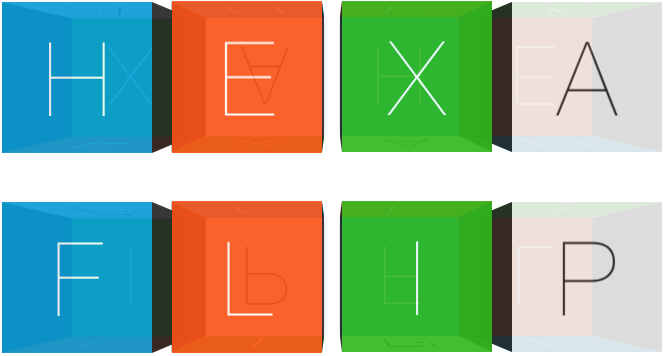Awesome

HexaFlip
Transform arrays of any length into cubes with infinite sides.
Featuring touch/mouse interaction, getter/setter methods, zero dependencies, and jQuery support.
Dan Motzenbecker, MIT License
Take a look at the Codrops article for a guide through the process and some demos.
Basic Usage
Create an instance by passing a DOM element and a key-value set of arrays:
var cubeSet = new HexaFlip(document.getElementById('my-el'),
{
prince: ['For You', 'Prince', 'Dirty Mind', 'Controversy', '1999', 'Around the World in a Day'],
curtis: ['Curtis', 'Roots', 'Super Fly', 'Back to the World', 'Got to Find a Way', 'Sweet Exorcist']
}
);
// you can also pass a selector string and HexaFlip will take the first matching element:
var firstDiv = new HexaFlip('div');
If a value is a URL, HexaFlip will set that side to the image it points to, preloading it automatically.
You can also pass objects as values with style and value keys
for some meticulous customization of different sides.
Make the former an object literal of CSS properties to customize the styling of that cube face.
var colorCube = new HexaFlip('#color-cube',
{
chromaSet: [
{
value: 'orange',
style: {
backgroundColor: '#e67e22',
fontWeight: 100
}
},
{
value: 'teal',
style: {
backgroundColor: '#1abc9c',
fontFamily: 'Futura'
}
},
{
value: 'yellow',
style: {
backgroundColor: '#f1c40f',
textDecoration: 'underline'
}
}
]
}
);
To enable horizontal rotation (like the photos above), pass it in the options:
var horizontalCube = new HexaFlip('#my-el2',
{
letters: ['α', 'β', 'γ', 'δ', 'ε', 'ζ', 'η', 'θ', 'ι', 'κ', 'λ', 'μ',
'ν', 'ξ', 'ο', 'π', 'ρ', 'σ', 'τ', 'υ', 'φ', 'χ', 'ψ', 'ω']
},
{
horizontalFlip: true,
size: 300
}
);
To set and get the values of the cubes:
cubeSet.setValue({ prince: '1999', curtis: 'Roots' });
cubeSet.getValue();
To rotate the cubes to the next or previous sides:
cubeSet.flip();
cubeSet.flipBack();
Events
To add custom DOM events, simply pass a key value object called domEvents to the instance's options:
//...
},
{
domEvents: {
mouseover: function(e, face, cube) {
face.style.backgroundColor = 'red';
},
mouseout: function(e, face, cube) {
face.style.backgroundColor = 'blue';
},
click: function(e, face, cube) {
console.log(face.innerHTML);
}
}
}
);
Every callback is passed the event object, the face element that triggered the event, and the cube
element the face belongs to. The callback is automatically bound to the HexaFlip instance
so this works properly.